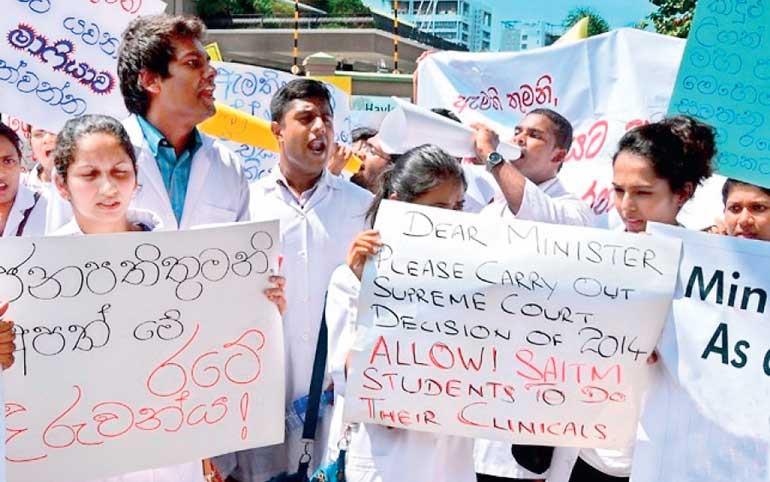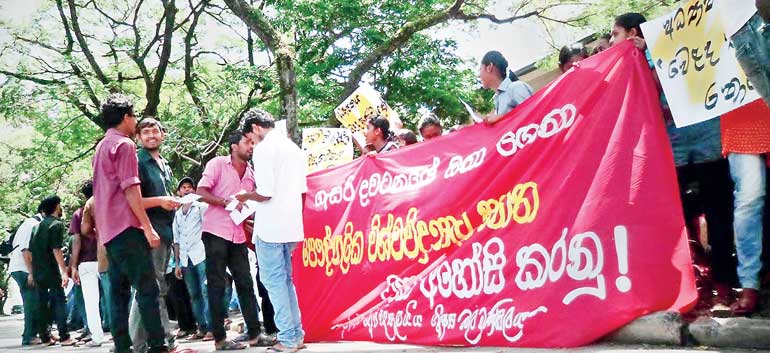Thursday Apr 25, 2024
Thursday Apr 25, 2024
Wednesday, 3 August 2016 00:00 - - {{hitsCtrl.values.hits}}


Lost in the for-or-against-SAITM debate is the ethicality of exchanging a medical degree obtained free-of-charge for higher remuneration in private practice locally or abroad, when the Government medical sector is in need of doctors in rural areas
The argument against private higher education is a strong one. Given two individuals, one able to afford to pay and the other not, it cannot be disputed that the one who can afford gets access to private higher education. The deeper truth is that wealth determines success in either public or private higher education.
 Fifty four percent of our youth who currently drop out school without an O/L certificate do not even get a chance to complain about private higher education. Clearly more than half of our population cannot have cognitive difficulties that prevent them from getting six passes with math and language in the GCE (O/L) examination. They do not succeed because they are disadvantaged. However, the more explicit case of inequity of somebody who get 3As but miss medical admission, and another gets 2Bs and an simple pass and gets into a private medical college makes for a more immediate and persuasive case.
Fifty four percent of our youth who currently drop out school without an O/L certificate do not even get a chance to complain about private higher education. Clearly more than half of our population cannot have cognitive difficulties that prevent them from getting six passes with math and language in the GCE (O/L) examination. They do not succeed because they are disadvantaged. However, the more explicit case of inequity of somebody who get 3As but miss medical admission, and another gets 2Bs and an simple pass and gets into a private medical college makes for a more immediate and persuasive case.
The solution to the crisis in medical education is not in the margins where the Government increases the intake bit by bit, but in addressing equity issues in a holistic manner. Currently, the intake to the medical stream is about 1,200 a year and graduation rates are expected to be the same. The Government picks this handful of students and give them a 100% free education, while another 10%, say, below the cut-off, have to pay 100% of the cost if they pursue private options.
Obviously, those well below the cut-off but with the money will go on to foreign universities or attend SAITM, the local option, leaving behind many frustrated youth. The anger is vented at the SAITM, the institution close to home. In the meantime, the Department of Health Services is on record saying there is a serious shortage of doctors, in rural areas in particular.
In a profession like medicine where there is a demand by Government for service in rural areas or lucrative private options, the truly equitable and efficient solution is to provide low interest loans to all for a for-fee education, and discount the loans on the basis of public service performed, with higher discounts for service in difficult areas.
For example, if a student graduates with Rs. 5 million in loans on average, say 10 or so years of public service could wipe out the loan. If a graduate wishes to migrate, the loan is his or hers to pay. No one is held in servitude and no one has to feel guilty and our rural hospitals would be staffed.
According to recent reports, the Prime Minister has asked for a five-year plan for addressing human resource needs in the health sector. Hopefully, there will be some out-of-the-box thinking in these new plans taking into account the marketability of a medical training and the needs of the other 93% other youth who are left out of the public higher education or technical and vocational education or training (TVET).
Shortage of doctors
The Government has good reasons to subsidise medical education. Speaking to Sandeshaya, the Sinhala service of BBC on 11 July, Dr. Palitha Mahipala, the Director General of the Health Services Department, had said that there is a shortage of 2,500 doctors, particularly in rural areas. This is not a problem that can be solved by one set of recruitments, he had said.
Currently there are nearly 17,000 doctors with one doctor for about 1,350 people. As the country, develops we can expect the demand for doctors to increase in parallel. For example, the UK has one doctor for 357 people.
As the Director General further elaborated, 1,200 doctors graduate annually from medical schools in Sri Lanka and another 300-350 return to Sri Lanka with foreign medical degrees. New units are opened to deal with new health issues and additional doctors will be needed to run those units. This is not a problem that can be solved by a big recruitment drive. It will be continuing problem, he had said.
The Director General did not talk about the attrition rate of doctors in the system – i.e. how many leave Government service at what point for what reason. Whatever the statistic, every person who leaves for personal benefits is one person too many to be subsidised in a country where public health needs are expanding and the average citizen bears the brunt of Government taxes.
Doubling the intake?
If the Government is to increase the doctors produced, it may have to spend Rs. 500,000 to 600,000 at a minimum in recurrent costs per student. Additional 1,000 places would require about 0.6 billion per year, not counting capital costs. The higher education budget for 2016 is Rs. 9 billion and 0.6 billion is a small increase, one might argue, but the issue is what else one could do with the money. Currently three billion is spent on the public TVET sector which serves 3% of the youth. Only three billion is budgeted for youth services which has to help 93% other youth.
 Will not solve quality issues
Will not solve quality issues
Currently our medical establishment prides itself on its quality of education. Our public health indicators continue to be high and our Government Medical Officers Association (GMOA) likes to take credit for that. But the credit is really due to the public health inspectors, public health nurses and midwives who do the frontline work with public health medical officers of health who oversee.
Our communicable disease rates are going down and the curative care doctors together with the preventive care colleagues can take a bow there, but lifestyle diseases such as heart problems and diabetes are alarmingly on the way up. Our doctors prescribe medicine, but are they doing enough in preventive care? The GMOA should stop congratulating itself and take a hard look at performance of 17,000 medical officers to see if the healthcare they deliver is adequate to meet the life-style disease threat.
Some of our medical officers are performing miracles in saving lives and guiding people to better lifestyles, and our specialists return with post-graduate experience outside of the country. Yet, what percent of the 17,000 medical officers are such doctors? Unless doctors themselves, or an independent entity, develop some rating system, we would not know.
One year of free tertiary education opportunity for all
If we are to address the equity issues, first and foremost is the inequity for 93% of a youth cohort who do not receive any support from the Government for tertiary education or training. In 2015, 320,000 or so youth turned 18. Of these 4% would end up in a public university and 3% in a public TVET institute. We know very little about other 93%. This is not an acceptable situation for a country where the majority of the workforce is in unskilled or low-skilled worker categories. Any increases in tertiary education should be targeted at youth to avoid the unskilled trap and give them helping hand to help themselves.
Many young people today pick up a certificate or diploma and then go on to study as they work. It is time that Government recognise that particular form of tertiary education and stop prioritising 7% of the youth on the basis of an examination system which is still loaded against the poor after more than 70 years of free education. A solution, for example, would be to make vouchers available for six months to one year of education or training in recognised education institutes to all youth.
Additional schooling from future earnings
The opponents of private higher education argue that education is not a commodity and that medical education in particular is sacrosanct, but the fact of the matter is that a certificate obtained free-of-charge has a market value. A medical degree carries value of a public nature, but the potential of private benefits are greater. Lost in the for-or-against-SAITM debate is the ethicality of exchanging a medical degree obtained free-of-charge for higher remuneration in private practice locally or abroad, when the Government medical sector is in need of doctors in rural areas.
We do not have statistics on how many graduates leave Government service each year. True, medical students should not be held in servitude. They should be free to leave, but they should be required to pay back the money spent on them. The mechanism for such pay back systems already exists with the exemplar reported from Australia in what is called Higher Education Loan Program (or HELP) which provides income contingent loans to students. This is essentially a future earnings model for funding higher education.
Avoiding the college loan trap
One issue that needs to borne in mind is that the future earnings model can be problematic in the long run. Higher education gospel has it that more education means more earnings, and borrowing for education is seen as an investment. This model has fuelled the growth of higher education in the US, but more and more students are graduating with large amounts of debt to find their degree-advantage is diminished now as a result of competition from graduates across the world in a highly-globalised economy.
Medical education is one field where we in Sri Lanka can experiment with a high expectation of success.